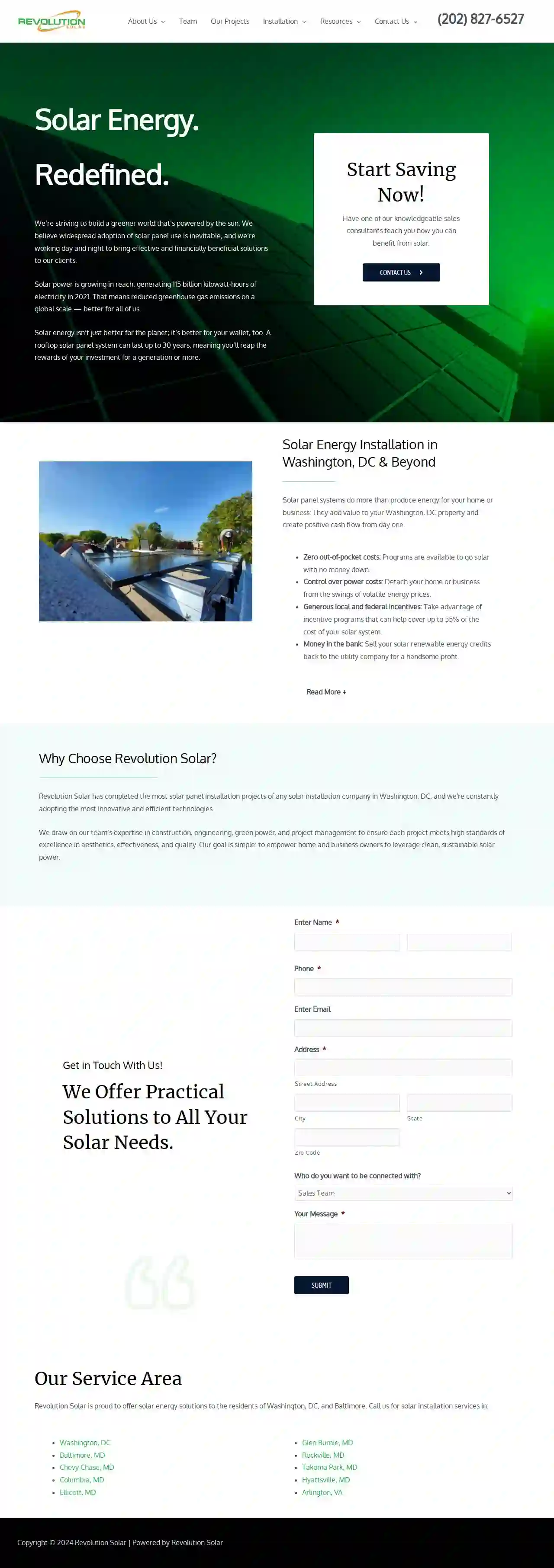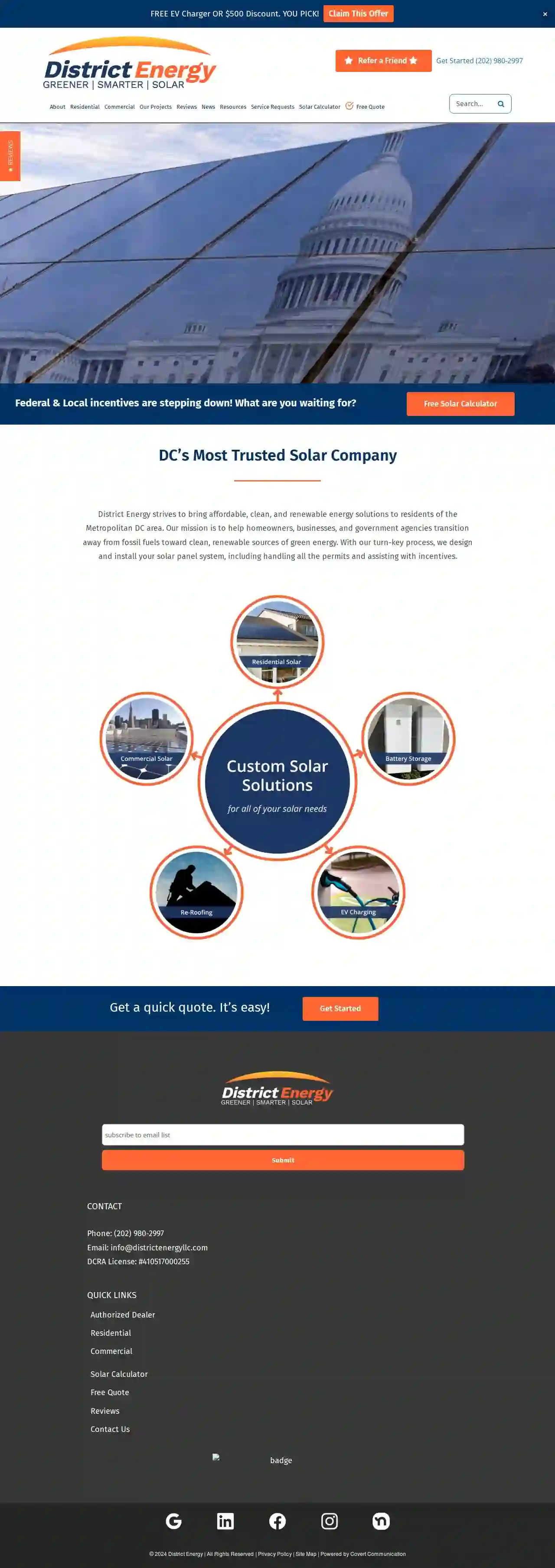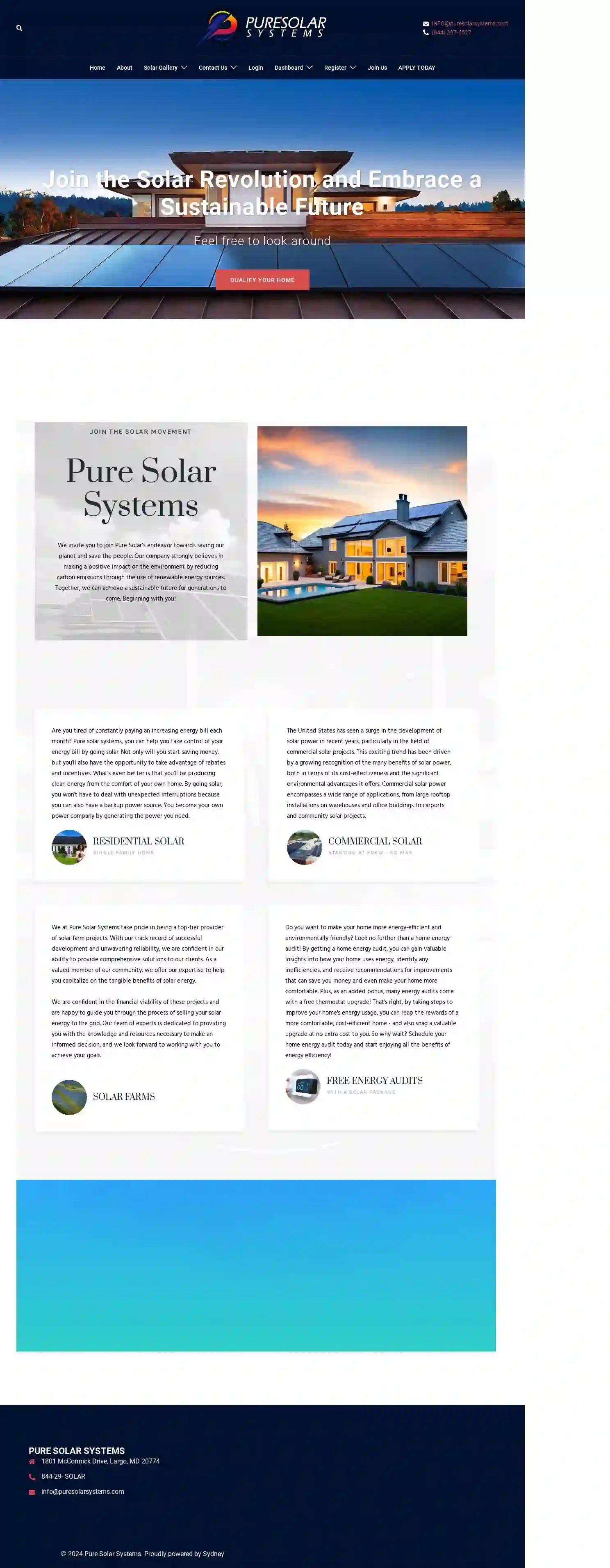Solar Installers Bryans Road
Best Solar Panels For Homes in Bryans Road
Receive multiple Solar Panel Installers quotes for your project today! Compare profiles, reviews, accreditations, portfolio, etc... and choose the best service.

Ultra Solar Group
510 146th Street, Suite 6, Ocean City, 21842, USThe Ultra Solar Group is a leading provider of solar energy solutions, offering a range of services including project development, engineering, procurement, and construction, as well as operation and maintenance. They are a SunPower dealer, providing high-quality solar panels and solutions for residential and commercial clients. Their team is certified and trained through SunPower and NABCEP workshops, ensuring top-notch installation and maintenance services.
- Services
- Why Us?
- Accreditations
- Gallery
Get Quote
Revolution Solar
526 reviewsRevolution Solar, Washington, DC, 123 Solar Street, 20001, USRevolution Solar is a leading provider of solar energy solutions in Washington, DC, and Baltimore. They offer a range of services including solar panel installation, solar panel replacement, rooftop solar systems, solar ground mounts, solar rooftop decks, solar pergolas, solar batteries, and commercial solar services. Their mission is to empower home and business owners to leverage clean, sustainable solar power. They have completed the most solar panel installation projects in Washington, DC, and constantly adopt innovative and efficient technologies.
- Services
- Why Us?
- Accreditations
- Our Team
- Testimonials
- Gallery
Get Quote
The Solar Brokers USA
533 reviews1601 Melford Blvd, Suite 400, Bowie, 20715, USSolar Brokers USA is a Mid-Atlantic based solar specialist located in Bowie, MD. We work with the top solar companies located in your area and state, including solar installers with home bases and offices in Maryland, Virginia, Pennsylvania, Delaware, DC and West Virginia. Save with Solar, easily. Purchase or lease a solar system from the comfort of your home. We also are able to offer solar programs across the USA with our Nationwide partners such as Freedom Forever and SunPower. Want to know how solar can work for your home or business? Call us at 443-758-0947 to schedule an in-home or virtual appointment, or simply to discuss solar in more detail.
- Services
- Why Us?
- Accreditations
- Our Team
- Testimonials
- Gallery
Get Quote
Truly Solar Inc
52 reviews9701 Apollo Drive, Largo, Maryland, 20774, USTruly Solar Inc. specializes in providing eco-friendly energy solutions through solar systems. They offer a variety of services including solar system repair, solar farm services, roof top solar panels, vehicle charging stations, ground mount solar installation, off-grid battery backup, and solar patio covers. Their mission is to assist homeowners and businesses in choosing the optimal method to power their lives, enhance their community, and preserve the environment.
- Services
- Why Us?
- Accreditations
- Our Team
- Testimonials
- Gallery
Get Quote
Khepri Energy
Suite A, Phoenix, MD, 3104 Jackson Ridge Court, 21131, USKhepri Energy is a leading provider of solar energy solutions, offering sustainable and renewable energy options for residential and commercial clients. With a focus on energy independence and long-term savings, Khepri Energy helps customers transition to solar power through various services including energy consulting, solar installation, and battery backup solutions. The company is dedicated to providing clean, eco-friendly energy and reducing reliance on fossil fuels.
- Services
- Why Us?
- Accreditations
- Our Team
- Testimonials
- Gallery
Get Quote
Solar Energy Services, Inc.
4.563 reviewsMillersville, Maryland, 1514 Jabez Run, 21108, USSolar Energy Services, Inc. is a leading solar energy solutions provider in the Mid-Atlantic Region. With over 40 years of experience, they offer innovative solar solutions that are affordable and sustainable. Their mission is to provide thoughtful design and safe, dependable installation of distributed solar energy systems, including solar PV and energy storage systems. They value honesty, integrity, respect, and long-term commitments to family, customers, and the company.
- Services
- Why Us?
- Accreditations
- Our Team
- Testimonials
- Gallery
Get Quote
Solar SME, Inc.
4.874 reviewsGrand Prairie, TX, 2630 Aero Drive, 75052, USSolarSME is a leading provider of solar energy solutions, offering a range of services including residential and commercial solar installations, solar unmounting and re-installation, solar maintenance and repair, and solar financing. With a commitment to sustainability and customer satisfaction, SolarSME aims to empower homes and businesses with clean, green energy.
- Services
- Why Us?
- Accreditations
- Our Team
- Testimonials
- Gallery
Get Quote
District Energy LLC
542 reviews123 Solar Street, Suite 100, Washington, 20001, USDistrict Energy LLC is a trusted solar company in the Metropolitan DC area, providing affordable, clean, and renewable energy solutions to residents, businesses, and government agencies. Their mission is to help transition away from fossil fuels toward clean, renewable sources of green energy. With a turn-key process, they design and install solar panel systems, including handling all permits and assisting with incentives.
- Services
- Why Us?
- Accreditations
- Our Team
- Testimonials
- Gallery
Get Quote
Pure Solar Systems
53 reviews1801 McCormick Drive, Largo, MD, 20774, USPure Solar Systems is a leading provider of solar energy solutions, dedicated to helping individuals and businesses reduce their carbon footprint and save on energy bills. With a focus on sustainability and customer satisfaction, Pure Solar Systems offers a range of services including residential solar, commercial solar, solar farms, and free energy audits.
- Services
- Why Us?
- Accreditations
- Our Team
- Testimonials
- Gallery
Get Quote
Mr Solar USA
123 Solar Way, Suite 100, Annapolis, 21000, USMr Solar USA is a company that takes pride in delivering quality solar power and battery storage systems to homes and businesses in Maryland, Washington D.C and Virginia. Our team of experienced professionals work diligently to ensure your system is installed and maintained correctly, so you can enjoy the benefits of solar energy for years to come. We believe that you should have the freedom to choose how to get your energy, without worrying about expensive utility bills or the next power shut down. Contact us today to find out how we can help you save money on your energy bill and give you peace of mind.
- Services
- Why Us?
- Accreditations
- Our Team
- Testimonials
- Gallery
Get Quote
Over 4,210+ Solar Installers on our platform
Our solar experts operate in Bryans Road & surrounding areas!
SolarCompaniesHub has curated and vetted the Best Solar Installers arround Bryans Road. Find a reliable business today.
Frequently Asked Questions About Solar Installers
- Solar Panel Warranty: From the panel manufacturer, typically covering defects in materials and workmanship for 10-25 years. Some manufacturers offer performance guarantees, ensuring a certain level of energy output over time.
- Solar Installation Warranty: From the solar installer, covering the quality of the installation work for 1-10 years. This warranty protects you from leaks, faulty wiring, or other issues caused by improper installation.
- Cash Purchase: The most straightforward option, providing the greatest long-term savings but requiring a larger upfront investment.
- Solar Loans: Loans specifically designed for solar installations, often with favorable terms and interest rates.
- Solar Leases: A third-party company owns the system and leases it to you, allowing you to go solar with little or no upfront cost, but you won't own the system or receive tax benefits.
- Power Purchase Agreements (PPAs): Similar to leases, but you pay for the electricity generated by the system, not the system itself.
- Home Equity Loans or Lines of Credit: Borrow against the equity in your home.
What kind of warranty should I expect for my solar panel system?
What is the lifespan of solar panels?
How can I finance my solar panel installation?
Can I go completely off-grid with solar panels?
What kind of warranty should I expect for my solar panel system?
- Solar Panel Warranty: From the panel manufacturer, typically covering defects in materials and workmanship for 10-25 years. Some manufacturers offer performance guarantees, ensuring a certain level of energy output over time.
- Solar Installation Warranty: From the solar installer, covering the quality of the installation work for 1-10 years. This warranty protects you from leaks, faulty wiring, or other issues caused by improper installation.
What is the lifespan of solar panels?
How can I finance my solar panel installation?
- Cash Purchase: The most straightforward option, providing the greatest long-term savings but requiring a larger upfront investment.
- Solar Loans: Loans specifically designed for solar installations, often with favorable terms and interest rates.
- Solar Leases: A third-party company owns the system and leases it to you, allowing you to go solar with little or no upfront cost, but you won't own the system or receive tax benefits.
- Power Purchase Agreements (PPAs): Similar to leases, but you pay for the electricity generated by the system, not the system itself.
- Home Equity Loans or Lines of Credit: Borrow against the equity in your home.